1. Introduction
 Below are some of my hot practical tips on how to build your club membership using social media, in particular Facebook. My experience is based on many years as a Director of several corporates responsible for marketing and business development, plus eight years of building my own small consulting practice, along with being responsible for the initial marketing and branding of Haresfoot Brewery and more recently BerkoBeerFest. I was the District 91 PR Manager last year (2017-18) and this year I have started Stevenage Speakers Club. This blog follows on from my webinar masterclass delivered last week (I will share the link to the video once live).
Below are some of my hot practical tips on how to build your club membership using social media, in particular Facebook. My experience is based on many years as a Director of several corporates responsible for marketing and business development, plus eight years of building my own small consulting practice, along with being responsible for the initial marketing and branding of Haresfoot Brewery and more recently BerkoBeerFest. I was the District 91 PR Manager last year (2017-18) and this year I have started Stevenage Speakers Club. This blog follows on from my webinar masterclass delivered last week (I will share the link to the video once live).
2. Marketing basics
A basic marketing principle is the 7 Touchpoints – typically people need to see something seven times before they take action, a kind of triangulation or. More specifically, septangulation. “Action” for us is someone coming to a meeting, subscribing to our emails or ultimately taking out membership. Some marketeers suggest people need seven touchpoints over three media, for example social media, word of mouth and flyers etc.
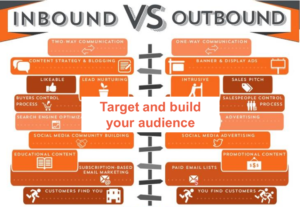 Over the last decade or so many companies have moved from outbound to inbound (or content) marketing. Outbound marketing is more salesy – websites, adverts and those horrible telesales calls saying “buy me”. Inbound marketing is when organisations create good useful content, so people choose to follow them (or subscribe), and begin to respect and to trust them. Thus, they create prime targets for selling to. In a world of GDPR, people freely offering their email address (subscribing) is even more important than ever, but they are entrusting organisations like Toastmasters with their personal data and saying “I’m interested, keep in touch with me”.
Over the last decade or so many companies have moved from outbound to inbound (or content) marketing. Outbound marketing is more salesy – websites, adverts and those horrible telesales calls saying “buy me”. Inbound marketing is when organisations create good useful content, so people choose to follow them (or subscribe), and begin to respect and to trust them. Thus, they create prime targets for selling to. In a world of GDPR, people freely offering their email address (subscribing) is even more important than ever, but they are entrusting organisations like Toastmasters with their personal data and saying “I’m interested, keep in touch with me”.
Good content includes free useful information, sharing of useful links, special offers for subscribers or original blogs etc. Then the organisation occasionally sells them something (outbound marketing), but only every 1 in 10 or so posts. Whilst “selling” is considered quite crass by some, at Toastmasters we are “selling” membership or maybe a ticket to an event such as a contest.
You may have heard of B2B and B2C marketing – Business to business or business to consumer (or end-user). In Toastmasters we mostly market B2C, but with corporate rather than community clubs it is more like B2B marketing. Whether you are B2B or B2C will affect the language used, whether posts are formal or fun etc, and also the marketing platforms used.
3. Marketing platforms
Social media platforms are a marketing tool and should be an integral part of your marketing strategy rather than an afterthought. There are thousands of social media platforms, but Wikipedia keeps a list of the major active social networking sites and that number is currently around 200. My advice is start out with one or two social media platforms and service them well, thus building your audience/following.
 I believe there are five key social media sites most relevant to Toastmasters. The five sites, along with their rankings by active users are: 1. Facebook (ranked #1), 2. YouTube (ranked #2 and also the second biggest search engine after Google), 3. Instagram (ranked #3 and the fastest growing), 4. Twitter (ranked #6) and 5. LinkedIn (ranked #13 perhaps because it is more business than personal). The latter two platforms are more useful for corporate clubs (B2B) and the former for community clubs (B2C).
I believe there are five key social media sites most relevant to Toastmasters. The five sites, along with their rankings by active users are: 1. Facebook (ranked #1), 2. YouTube (ranked #2 and also the second biggest search engine after Google), 3. Instagram (ranked #3 and the fastest growing), 4. Twitter (ranked #6) and 5. LinkedIn (ranked #13 perhaps because it is more business than personal). The latter two platforms are more useful for corporate clubs (B2B) and the former for community clubs (B2C).
Facebook used to be just for personal use, but lots of businesses now use it. Mostly because, when an end-user follows a business or likes their product, it is a personal endorsement – which is much more powerful than outbound/direct advertising. Most times (not every time) when someone likes a page it appears in their friend’s news feed, and their friends are also notified of which events they are going to. So, do get you friends and follow Toastmasters to like and share your club page, posts and events.
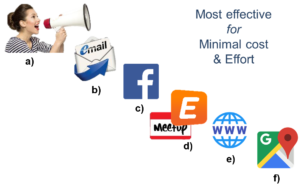 There are other very useful social media and marketing platforms. Don’t forget word of mouth, local advertising in newspapers or by flyers and posters etc. Email is still a key marketing tool, event platforms are also great, and google maps and your website are all useful. Below are my favourite platforms in order of the most effective for minimal cost and effort.
There are other very useful social media and marketing platforms. Don’t forget word of mouth, local advertising in newspapers or by flyers and posters etc. Email is still a key marketing tool, event platforms are also great, and google maps and your website are all useful. Below are my favourite platforms in order of the most effective for minimal cost and effort.
a) Word of mouth – It doesn’t cost anything and it is powerful. If each member introduced one new member the club would double. But it has limited reach i.e. friends of existing members.
b) Email – Still key for marketing as we can contact people directly and inform them of offers and events etc. If people provide their email address it’s a strong buying sign – the want to know more and we just need to make it really easy for them to attend a meeting because, as we put on great meetings, we know we can then convert them to members. For a new club, building membership, you probably need to be emailing weekly. For an established club, maybe monthly to keep members up to date and interested.
I recommend using a website platform like MailChimp or ConstantContact. These applications allow you to compile and manage your email lists; you can also see who is opening emails, clicking on any links (like events) and sharing your emails. They are also GDPR compliant and have unsubscribe buttons.
But how do we get people’s email addressed in the first place? Please don’t buy email lists or skim them off other websites. Firstly, it’s against GDPR rules but, more importantly, the majority of those people aren’t targeted or interested anyway – remember we use inbound marketing because we want the email addresses of those who trust us and find us useful! That’s were social media comes in. We can use platforms like Facebook to build an audience. Through good content we attract followers and convince them to subscribe to our email lists (or attend meetings).
c) Facebook – Mostly free at the moment (no joining fee) so make the most of it. More about Facebook in the next section.
d) Eventbrite and MeetUp – These are great for advertising upcoming events and meetings. Eventbrite free if you don’t charge for your event (then there is approximately an 8% booking and processing fee). MeetUp has a monthly subscription fee (approximately £7.50 per month) but it can be shared between three clubs. What I like about these platforms is that they also act as search engines – they have good Search Engine Optimisation (SEO) so appear high on Google rankings, but also nearby events pop-up when people are searching on their sites.
e) Website – Eventually you will require a website as it is somewhere to collate all your useful information – where and when you meet etc. You may even use it to host your own content like blogs or useful links. Check out FreeToastHost or use a website builder you are familiar with to quickly create a landing page.
It is really important that people can easily contact you via your website. Provide an email address or a contact form. Even better is to use a contact form provided by your email platform, like MailChimp, or create a link on your website to an email server landing page where people can sign up directly (and automatically) to your emails, as I did with Stevenage Speakers Club.
f) Google Maps – You can easily embed a Google map of your location on your website. Or alternatively use the Google my Business facility to add your club to Google Maps, which is great for SEO and google rankings.
4. Facebook tips & tricks
This section covers some Facebook basics and practical tips that will help you attract new members.
Page versus group – Pages act like your personal profile but for an organisation. It allows more control over content and is a little more structured than groups. Groups act more like places for like-minded people to interact and chat.
Posts – Most people are familiar with posting on Facebook pages, but remember to add a picture, a video or a (website) link for more impact. Avoid lots of text in your posts – also note that Facebook prefers pictures without text (particularly important when boosting posts). Remember to share lots of nice content (yours and others) then occasionally (1 in 10 posts) sell an event or membership. You can schedule posts using HootSuite for Facebook, Twitter and Instagram, however it costs so consider collating your posts in a Word document then cutting and pasting them in to scheduled Facebook posts (select “schedule” rather than “publish”).
Interactions – It’s really important to interact with your followers by commenting on or sharing their posts (or reply or retweet in Twitter). This should be daily unscheduled activity. So, I recommend downloading the social media apps so that you can dip in and out of Facebook (and Twitter) in your downtime. The more interactions you have, the more people become aware of you and so your following will grow.
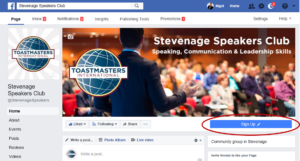 Asking questions, or even better posting competitions or quizzes are a great form of interaction. At Haresfoot Brewery I ran a daily competition (catchphrase) for the 25 days in December leading up to Christmas. Correct answers were awarded with a free pint at the brewery shop – it was great coverage and also people came to the shop and invariably purchased more goods.
Asking questions, or even better posting competitions or quizzes are a great form of interaction. At Haresfoot Brewery I ran a daily competition (catchphrase) for the 25 days in December leading up to Christmas. Correct answers were awarded with a free pint at the brewery shop – it was great coverage and also people came to the shop and invariably purchased more goods.
Rather than them just giving an answer you ask people to share their answer in a post, or you might even get them to go to a landing page where they enter their answer and email address. The biggest downside to Facebook is you can’t easily extract email addresses, so competitions help; but also add a sign-up button to the top of your page.
 Invites – A key way to grow is to first invite your friends to like your club page and also ask them to invite their friends too. Invite those friends potentially interested or in the local area. You can also invite those who like posts to like your page (click on those who have liked a post or event). Also remembers to ask your members and friends to share your posts. Note, you can only invite friends to like your page when you view it as a “page visitor”.
Invites – A key way to grow is to first invite your friends to like your club page and also ask them to invite their friends too. Invite those friends potentially interested or in the local area. You can also invite those who like posts to like your page (click on those who have liked a post or event). Also remembers to ask your members and friends to share your posts. Note, you can only invite friends to like your page when you view it as a “page visitor”.
Events – When starting out create Facebook events for your meetings (you may move to EasySpeak once established). Invite your followers and friends to join regular club meetings and special events, like contests. It not only indicates the numbers attending, but it advertises the event to friends of friends, and also joiners get automatically updated with new event information and photos. Those who join events can also be invited to like your page. Avoid duplicate events, if it is a joint venture (maybe between two clubs) then make your partner a co-host of the event – it is then automatically added to their page. Events can also be directly linked to Eventbrite for ticketing and even more awareness (so also create the event in Eventbrite).
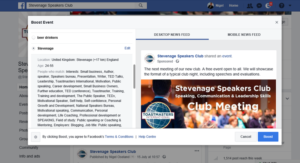 Boosts – Once you’ve exhausted your friends and followers, you will need to reach new followers; that’s were boosting comes in. You can boost an event or a post. If you already have a lot of followers and want them to attend an event (or take other action) then select the option to boost to you page followers. Otherwise you will need to create a target audience and boost to them – you can choose the area and also special interests like “public speaking”, “Ted talks”, “personal development” and “presentation skills”.
Boosts – Once you’ve exhausted your friends and followers, you will need to reach new followers; that’s were boosting comes in. You can boost an event or a post. If you already have a lot of followers and want them to attend an event (or take other action) then select the option to boost to you page followers. Otherwise you will need to create a target audience and boost to them – you can choose the area and also special interests like “public speaking”, “Ted talks”, “personal development” and “presentation skills”.
I’ve found that boosting posts works better than boosting actual Facebook events – but you can boost a post with a link to a Facebook event or even better to an externa link such as Eventbrite. Furthermore, boosts appear to be more successful for posts which have already got good organic (natural) reach – it’s multiplicative or like amplification (better to amplify something rather than nothing). Start with a £1 per day boost and see how much reach you get before committing to £5 to £10 boots.
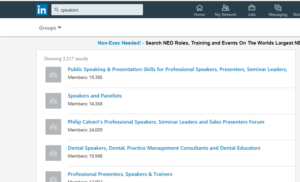 Groups – Have a go at posting your events and page link on other organisations’ pages and groups. Search for relevant local groups, for example Stevenage has quite a few local interest groups which I post on each week to promote the new Stevenage Speakers Club. You might also try posting on specialist interest groups or professions like authors or bloggers.
Groups – Have a go at posting your events and page link on other organisations’ pages and groups. Search for relevant local groups, for example Stevenage has quite a few local interest groups which I post on each week to promote the new Stevenage Speakers Club. You might also try posting on specialist interest groups or professions like authors or bloggers.
5. Using other social media
I’ve focussed on Facebook in this blog and haven’t the space to go through other social media platforms. However, the principles for Facebook I have highlighted above also apply to most social media platforms. For example, with LinkedIn I often “hi-jack” other groups where I post my events or blogs etc to reach a wider new audience of potential Toastmasters members.
Give it a go, experiment, have fun and use social media wisely to build your clubs!
